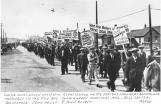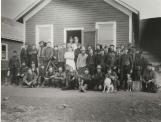2
In the year 1919 the first World War was over, but the labour war, strikes and violence were just beginning. In March, a new all-Canadian union entered the scene. This union was called "the One Big Union" (OBU) and its goal was to unite all workers under one umbrella making for one powerful force. In the beginning, One Big Union was very appealing to many miners, especially since they were dissatisfied with the UMWA, the united Mine Workers of America.Miners were unhappy with the UMWA especially when it came to union dues. It seemed that the union dues paid by Drumheller miners went to head office in the United States and never made it back to the valley.
There were other issues as well that the UMWA was ignoring. Many miners had no control over wage rollbacks or the fashion in which they were paid. Some mine managers chose to pay their men in company scrip not cash. Company scrip was money that could only be spent in company owned stores.
" A person living there was not only forced to live in a house owned by the company he worked for, but was also forced to buy his food and living necessities at the company general store, including his tools! Since there was no competition prices were very high and if the wages went up, the same day prices in the store went up."
- Stan Brooker -
In the spring, the Drumheller coal miners voted to withdraw from the unsupportive UMWA (United Mine Workers of America union) and join the OBU. The mine operators retaliated by joining forces, thirteen mines in total, and refused to recognize the One Big Union. The managers already had an agreement with the UMWA and they were sticking to it. Thus began one of the most important strikes in the valley's history.
As the tension grew, the managers began to fear damage of mine property as a result of angry strikers. Orders were piling up, and they were desperate to get the miners back to work.
5
At this time, the labour market was flooded with returning war veterans. Instead of the hero's welcome they were expecting, these men were met with unemployment, labour unrest and a town that was being torn in two. Because many miners had immigrated from the countries they had been fighting against, vets thought of them as the "alien element". In no time at all the mine operators had turned the returning war veterans against the striking miners. They were hired as "special constables" to protect their mine property and force miners back to work.7
These "Specials" were paid a hefty $10 a day as well as all of the liquor they could hold. Once the "Specials" were well oiled, they would be armed with pick axes and brass knuckles. These liquid brave strike busters picked up a new workforce daily. For miners, travelling in herds became the norm. There was safety in numbers. Many miners could not even find security in their own homes. On many occasions special constables would intrude on miner's homes and request or rather force miners to work. The workers that put up a fight faired far worse than those who didn't. Those who showed resistance towards the constables were beaten and left for dead 30 miles out of town. This was a harsh warning to others who would try to resist the forces of the constables.8
Four miners standing outside of their boarding house20th Century
Lehigh, Alberta
 Credits:
Credits:Atlas Coal Mine Historical Society
9
The miners' collective steam was running out. With the government, the UMWA ,and the mine operators against them, the OBU began to fall apart. As the vision and promises of the OBU disappeared, many miners joined the UMWA so they could go back to work. It was a strike or starve situation. Soon the UMWA would send in union organizers to break the OBU's back for good.10
Wayne local union UMW of A. Represented in the May Day parade1930's
Drumheller, Alberta
 Credits:
Credits:Wayne Community Association



